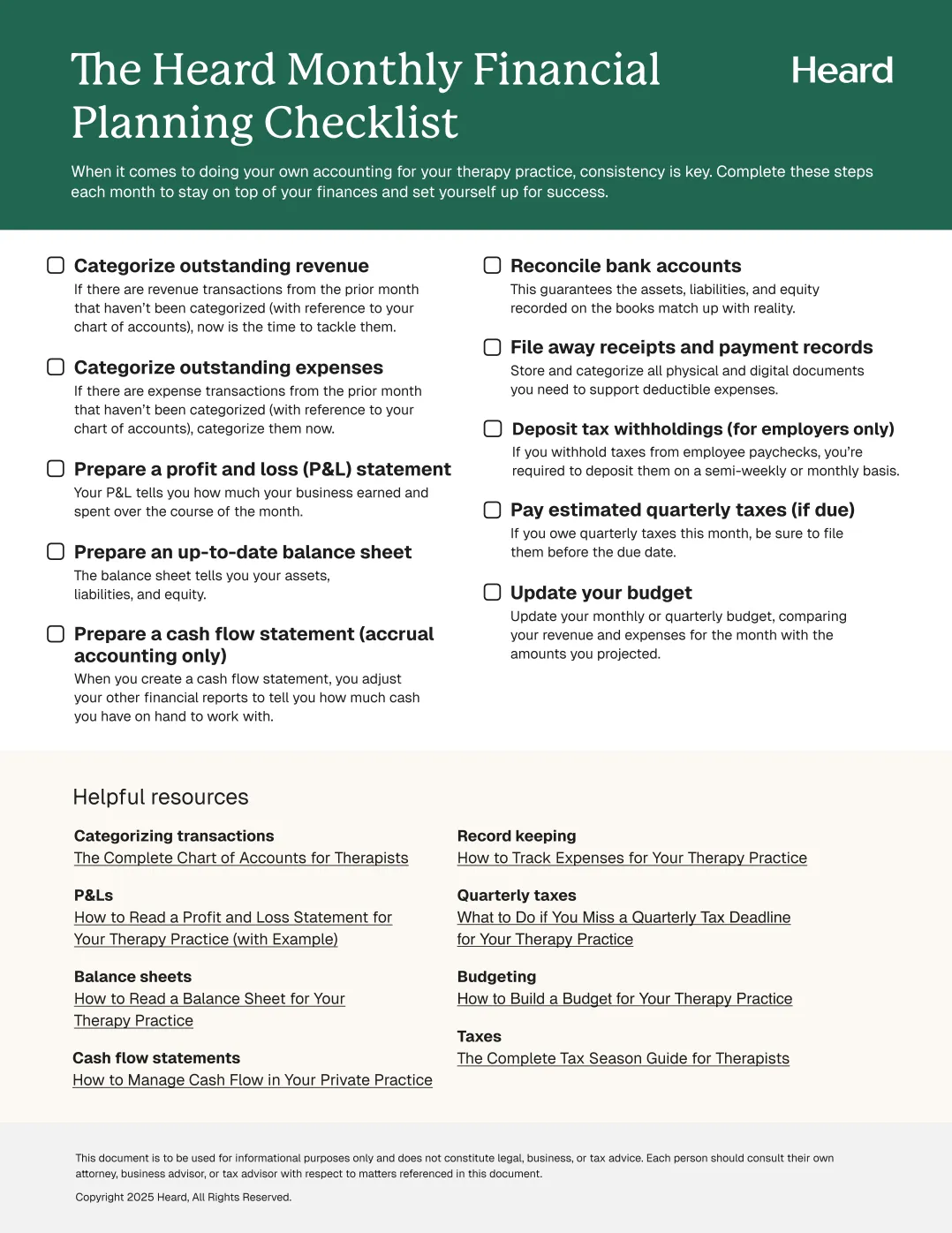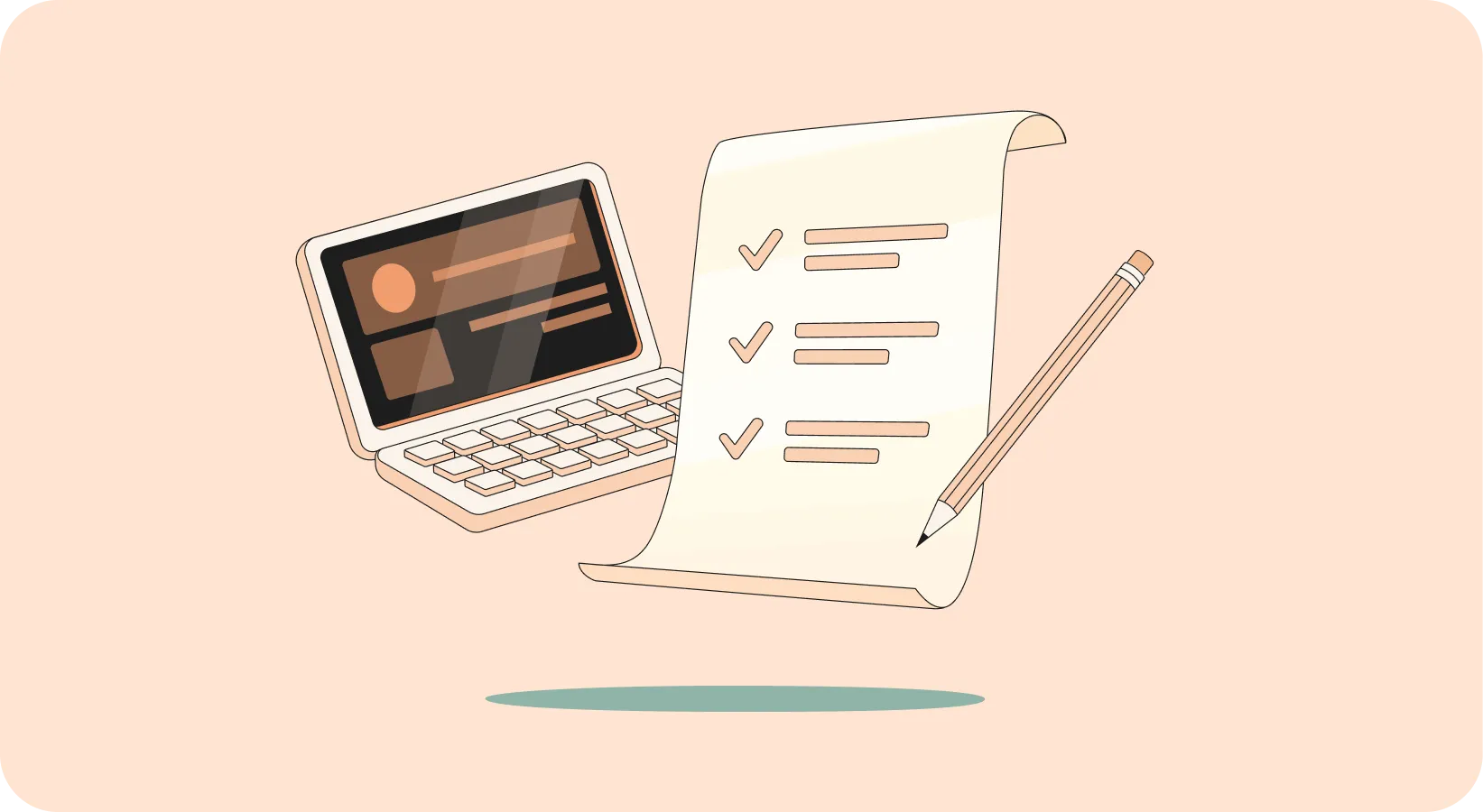If you’ve recently started your own therapy practice and you’re new to bookkeeping and accounting, it’s important to understand some key terms. This short glossary will get you started—whether you’re doing your own bookkeeping and accounting, or having the experts at Heard handle it for you.
{{resource}}
Accounting
The process of taking day-to-day financial records, prepared as part of the bookkeeping process, and using them to generate financial statements that give you insight into how your business is performing. These insights can help you build budgets, prepare and file your taxes, and plan how to scale your business. More advanced moves, like changing your business entity or setting up payroll, also fall under the broad term “accounting.”
Accrual accounting
One of two accounting methods, along with cash basis accounting. Using the accrual method, when you earn money, you record it as revenue on the books (accounts receivable), even if you haven’t actually received the cash payment. Similarly, when you incur debt, it’s recorded as an expense, even if you haven’t actually paid it (accounts payable).
Asset
Anything of value your business owns. Assets are either tangible (they exist physically) or intangible (they exist on paper). Your practice’s tangible assets may include furniture, computers, books, therapeutic tools, or the building where your office is based. Intangible assets may include cash or accounts receivable (money someone owes you).
Balance sheet
One of the three main financial statements (along with profit and loss and cash flow statements), your balance sheet reports all your business’s assets and liabilities up to a certain date. Balance sheets are typically prepared on a monthly or quarterly basis.
Bookkeeping
The practice of recording and categorizing day-to-day transactions for your business. Every time you earn money, it’s recorded in your general ledger, and categorized according to what type of revenue it is. Every time you spend money, the same thing happens, except it’s categorized according to what type of expense it is. Looking at your general ledger, you can get an overview of the different ways you spend and earn money. The information generated by bookkeeping is used to create financial statements.
Cash basis accounting
One of two accounting methods, along with accrual accounting. Cash basis accounting records income when you receive it in the form of cash, and records expenses when the cash to pay them leaves your bank account. Contrast this with accrual accounting, which records income and expenses when they’re earned or incurred, respectively, regardless of whether you have the cash in hand.
Cash flow
The measure of how quickly revenue you earn becomes cash. If you use the accrual accounting method, when your business is owed money, the amount is recorded as income you’ve earned and an asset on your balance sheet. However, you don’t actually have the cash in your bank account, so you can’t spend it. Once the debt is paid, it becomes cash. Tracking cash flow is important for making sure you can cover your expenses.
Cash flow statement
One of the three major financial statements, along with the profit and loss statement (P&L) and balance sheet. The cash flow statement is only necessary if you use the accrual accounting method. It fixes discrepancies between how much you’ve earned versus how much cash you’ve received, so you understand how much cash (versus other assets, like accounts receivable) you have to work with.
Chart of accounts
In bookkeeping, an account (also called a ledger) is a category of revenue or expense. Your chart of accounts lists all of these categories, and you or your bookkeeper refer to it when categorizing transactions.
Deductible expense
An expense you can report on your tax return in order to reduce your taxable income. The amount of a deductible expense is either wholly or partially deducted from your gross income. Since you must pay income tax on all income you report, this reduces your total tax burden. See our complete list of tax deductions for therapists.
Double-entry bookkeeping
The most common method of bookkeeping. For every transaction, two entries are made: One for cash going into an account (referred to as a debit) and another for cash leaving a different account (referred to as a credit). Double entry accounting helps ensure your books are accurate, and any professional bookkeeper you hire will use it.
{{resource}}
Employer insurance number (EIN)
Even if you don’t have any employers, your business requires an EIN in order to open a bank account and form certain business entities like limited liability companies (LLCs). Your EIN is used to identify your business on all federal tax filings. Learn how to get an EIN for your therapy practice.
Financial projection
A model of your business’s future financial performance based on past trends and current trends. You might use a financial projection to estimate how much you expect to earn during a certain period, or how much cash you’ll have in the bank by a certain date. Or you may use a financial projection to model the impact of potential changes to how you do business—for instance, taking on additional clients, increasing your fees, or reducing certain expenses.
Financial report
An overview of financial information for your business, covering a particular period, and based on transactions recorded in your general ledger. The three major financial reports are the profit and loss statement (P&L), balance sheet, and cash flow statement.
General ledger
In bookkeeping, the general ledger is the main document that tracks all your business transactions, categorizing each as either a debit or a credit (in double-entry bookkeeping) and assigning it a category (an account) based on your chart of accounts.
Liability
Money your business owes. Liabilities are reported on your balance sheet, along with your assets. Typical liabilities include loan debt, money owed contractors, and unpaid bills.
Limited liability company (LLC)
A type of business registered on the state level that can elect one of a number of different business entity types or tax filing statuses at the federal level. An LLC gives you more liability protection than a sole proprietorship (the default entity type for new businesses), while also giving you more flexibility in how you file your taxes. Learn how to choose a business entity type for your therapy practice.
Owner’s draw
An owner’s draw is the money you pay yourself from your business’s earnings. Depending on your business structure, you may either be an employee of your own business (in which case you earn a paycheck) or you and your business may be identical for tax purposes (in which case you pay yourself an owner’s draw). For the sake of keeping your bookkeeping organized, it’s important to officially take an owner’s draw, as opposed to dipping into your business bank account whenever you personally need cash.
Payroll tax
Money withheld from an employee’s paycheck. You must withhold payroll tax even if you’re paying yourself as an employee. “Payroll tax” is an umbrella term covering federal and state income tax, Social Security payments, and Medicare.
Profit and loss statement (P&L)
One of the three basic financial reports, along with the balance sheet and cash flow statement. Sometimes called an income statement. The P&L tells you how much money you earned (revenue) and how much you spent (expenses) over a particular period, and your total income (revenue minus expenses). P&Ls for your therapy practice may be generated monthly or quarterly, and annually for the purpose of filing taxes.
Qualified business income (QBI) deduction
The QBI deduction allows you to deduct up to 20% of your gross income for the year, provided your business meets certain requirements. It can be a bit complex to figure out, but has the potential to significantly lower your tax burden. Check out our guide to the QBI deduction for therapists.
Quarterly estimated taxes
If your practice owes more than $1,000 in federal taxes for the year, you’re required to file quarterly estimated taxes. Effectively, you’re paying tax on the money you’re earning during the year, rather than waiting until after the year ends to pay a lump sum. Learn more from our guide to quarterly estimated taxes for therapists.
—
Want to lower your tax bill? Our guide to the most valuable write-offs for therapists is the place to start.
This post is to be used for informational purposes only and does not constitute legal, business, or tax advice. Each person should consult their own attorney, business advisor, or tax advisor with respect to matters referenced in this post.
Bryce Warnes is a West Coast writer specializing in small business finances.
{{cta}}
Manage your bookkeeping, taxes, and payroll—all in one place.

Discover more. Get our newsletter.
Get free articles, guides, and tools developed by our experts to help you understand and manage your private practice finances.





